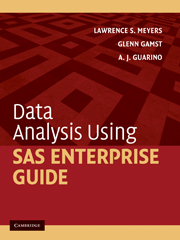Book contents
- Frontmatter
- Contents
- Preface
- Acknowledgments
- I Introducing SAS Enterprise Guide
- II Performing Analyses and Viewing Output
- III Manipulating Data
- IV Describing Data
- V Score Distribution Assumptions
- VI Correlation and Prediction
- VII Comparing Means: The t Test
- 20 Independent-Groups t Test
- 21 Correlated-Samples t Test
- 22 Single-Sample t Test
- VIII Comparing Means: ANOVA
- IX Nonparametric Procedures
- X Advanced ANOVA Techniques
- XI Analysis of Structure
- References
- Author Index
- Subject Index
22 - Single-Sample t Test
Published online by Cambridge University Press: 05 June 2012
- Frontmatter
- Contents
- Preface
- Acknowledgments
- I Introducing SAS Enterprise Guide
- II Performing Analyses and Viewing Output
- III Manipulating Data
- IV Describing Data
- V Score Distribution Assumptions
- VI Correlation and Prediction
- VII Comparing Means: The t Test
- 20 Independent-Groups t Test
- 21 Correlated-Samples t Test
- 22 Single-Sample t Test
- VIII Comparing Means: ANOVA
- IX Nonparametric Procedures
- X Advanced ANOVA Techniques
- XI Analysis of Structure
- References
- Author Index
- Subject Index
Summary
Overview
A third and much less widely used application of the t test focuses on a situation in which we have data from a single sample and want to determine if it is likely that the sample had been drawn from a population whose parameter (typically a mean) is specified. Here are two examples of occasions in which we might employ such a test (the second based on an example used by Runyon, Coleman, & Pittenger, 2000).
First, the nationwide incidence for infectious disease D is known. Call this the population mean or parameter. The 17 townships surrounding city C appear to have a higher incidence of the disease. We can record the incidence values for these 17 townships, giving us a sample of 17 cases. We can then ask if the mean of the sample is significantly different from the population parameter.
Second, a researcher wishes to determine if the four-alternative multiple-choice questions in a reading comprehension exam contain cues to the correct answer. She therefore administers the test questions without the reading passages to 23 students who are instructed to answer the questions as best they can. If nothing but chance was in play, students should score 25% correct, and that is the population parameter of relevance. The percentage correct for the 23 students comprises the distribution of scores.
- Type
- Chapter
- Information
- Data Analysis Using SAS Enterprise Guide , pp. 206 - 210Publisher: Cambridge University PressPrint publication year: 2009



